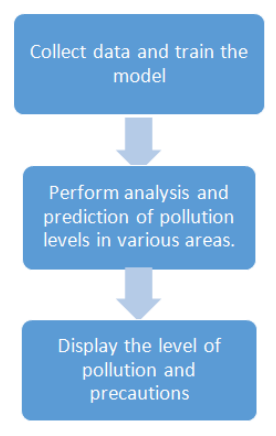Air Pollution Detection and Control System Using ML Techniques
Main Article Content
Abstract
In present times, air pollution is increasing day by day, depriving the health of many people due to the various toxic components in air. So, it is necessary to monitor and detect the levels of pollution in various areas and try to control it by taking precautionary actions. Air pollution detection and control system is all about detecting the level of pollution in a particular area based on the amount of polluting components and proposing the measures to control the pollution. Analysis is made on the regions of Visakhapatnam city in Andhra Pradesh, India and grouped based on their pollution and displayed along with each component level, reasons for the pollution depending on each component and measures that can be followed. Apart from this, we also display list of top 10 regions with the highest values for each component which can be used to identify the harmful regions based on the toxic components.
Article Details
References
Soumyadeep Sur;Rohit Ghosal;Rittik Mondal, "Air Pollution Hotspot Identification and Pollution Level Prediction in the City of Delhi”, 2020 IEEE 1st International Conference for Convergence in Engineering (ICCE), 2020.
Anandharajan TRV, Vignajeth KK, Hariharan GA, Jijendiran R. Identification of outliers in pollution concentration levels using anomaly detection. In: 2016 International Conference on Computational Techniques in Information and Communication Technologies (ICCTICT). New Delhi (2016). p. 433–8. doi: 10.1109/ICCTICT.2016.7514620.
Wang P, Chen K, Zhu S, Wang P, Zhang H. Severe air pollution events not avoided by reduced anthropogenic activities during COVID-19 outbreak. Resour Conserva Recycl. (2020) 158:104814. doi: 10.1016/j.resconrec.2020.104814.
A. Gupta, A. Gupta, K. Jain and S. Gupta, "Noise pollution and impact on children health", The Indian Journal of Pediatrics, vol. 85, no. 4, pp. 300-306, 2018.
S. K. Shah, Z. Tariq, J. Lee and Y. Lee, "Real-Time Machine Learning for Air Quality and Environmental Noise Detection," 2020 IEEE International Conference on Big Data (Big Data), 2020, pp. 3506-3515, doi: 10.1109/BigData50022.2020.9377939.
S. Zhang, X. Li, Y. Li and J. Mei, "Prediction of Urban PM2.5 Concentration Based on Wavelet Neural Network," 2018 Chinese Control And Decision Conference (CCDC), 2018, pp. 5514-5519, doi: 10.1109/CCDC.2018.8408092.
B. R. Subrahmanyam, A. Gautam Singh and P. Tiwari, "Air Purification System for Street Level Air Pollution and Roadside Air Pollution," 2018 International Conference on Computing, Power and Communication Technologies (GUCON), 2018, pp. 518-522, doi: 10.1109/GUCON.2018.8674934.
S. Jiyal and R. K. Saini, "Prediction and Monitoring of Air Pollution Using Internet of Things (IoT)," 2020 Sixth International Conference on Parallel, Distributed and Grid Computing (PDGC), 2020, pp. 57-60, doi: 10.1109/PDGC50313.2020.9315831.
H. ALTINÇÖP and A. B. OKTAY, "Air Pollution Forecasting with Random Forest Time Series Analysis," 2018 International Conference on Artificial Intelligence and Data Processing (IDAP), 2018, pp. 1-5, doi: 10.1109/IDAP.2018.8620768.
M. Etkind, "Air pollution-an overview," IEE Colloquium on Pollution of Land, Sea and Air: An Overview for Engineers, 1995, pp. 10/1-10/6, doi: 10.1049/ic:19951017.
T. Hastie, R. Tibshirani, J. Friedman. The Elements of Statistical Learning, 2nd edition, 2008.
Dietel and Dietel : “Internet and World Wide Web – How to Program”, 5th Edition, PHI/Pearson Education, 2011.

